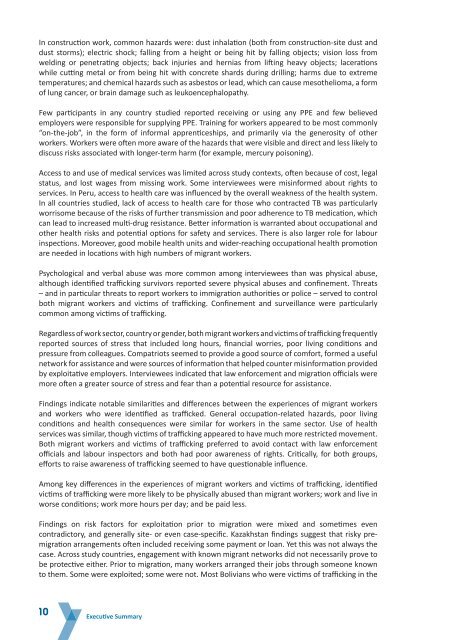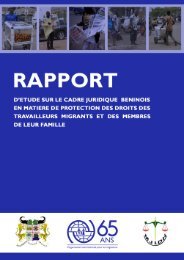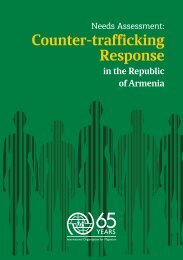Labour Exploitation Trafficking and Migrant Health
labour_exploitation_trafficking_en_0
labour_exploitation_trafficking_en_0
You also want an ePaper? Increase the reach of your titles
YUMPU automatically turns print PDFs into web optimized ePapers that Google loves.
In construction work, common hazards were: dust inhalation (both from construction-site dust <strong>and</strong><br />
dust storms); electric shock; falling from a height or being hit by falling objects; vision loss from<br />
welding or penetrating objects; back injuries <strong>and</strong> hernias from lifting heavy objects; lacerations<br />
while cutting metal or from being hit with concrete shards during drilling; harms due to extreme<br />
temperatures; <strong>and</strong> chemical hazards such as asbestos or lead, which can cause mesothelioma, a form<br />
of lung cancer, or brain damage such as leukoencephalopathy.<br />
Few participants in any country studied reported receiving or using any PPE <strong>and</strong> few believed<br />
employers were responsible for supplying PPE. Training for workers appeared to be most commonly<br />
“on-the-job”, in the form of informal apprenticeships, <strong>and</strong> primarily via the generosity of other<br />
workers. Workers were often more aware of the hazards that were visible <strong>and</strong> direct <strong>and</strong> less likely to<br />
discuss risks associated with longer-term harm (for example, mercury poisoning).<br />
Access to <strong>and</strong> use of medical services was limited across study contexts, often because of cost, legal<br />
status, <strong>and</strong> lost wages from missing work. Some interviewees were misinformed about rights to<br />
services. In Peru, access to health care was influenced by the overall weakness of the health system.<br />
In all countries studied, lack of access to health care for those who contracted TB was particularly<br />
worrisome because of the risks of further transmission <strong>and</strong> poor adherence to TB medication, which<br />
can lead to increased multi-drug resistance. Better information is warranted about occupational <strong>and</strong><br />
other health risks <strong>and</strong> potential options for safety <strong>and</strong> services. There is also larger role for labour<br />
inspections. Moreover, good mobile health units <strong>and</strong> wider-reaching occupational health promotion<br />
are needed in locations with high numbers of migrant workers.<br />
Psychological <strong>and</strong> verbal abuse was more common among interviewees than was physical abuse,<br />
although identified trafficking survivors reported severe physical abuses <strong>and</strong> confinement. Threats<br />
– <strong>and</strong> in particular threats to report workers to immigration authorities or police – served to control<br />
both migrant workers <strong>and</strong> victims of trafficking. Confinement <strong>and</strong> surveillance were particularly<br />
common among victims of trafficking.<br />
Regardless of work sector, country or gender, both migrant workers <strong>and</strong> victims of trafficking frequently<br />
reported sources of stress that included long hours, financial worries, poor living conditions <strong>and</strong><br />
pressure from colleagues. Compatriots seemed to provide a good source of comfort, formed a useful<br />
network for assistance <strong>and</strong> were sources of information that helped counter misinformation provided<br />
by exploitative employers. Interviewees indicated that law enforcement <strong>and</strong> migration officials were<br />
more often a greater source of stress <strong>and</strong> fear than a potential resource for assistance.<br />
Findings indicate notable similarities <strong>and</strong> differences between the experiences of migrant workers<br />
<strong>and</strong> workers who were identified as trafficked. General occupation-related hazards, poor living<br />
conditions <strong>and</strong> health consequences were similar for workers in the same sector. Use of health<br />
services was similar, though victims of trafficking appeared to have much more restricted movement.<br />
Both migrant workers <strong>and</strong> victims of trafficking preferred to avoid contact with law enforcement<br />
officials <strong>and</strong> labour inspectors <strong>and</strong> both had poor awareness of rights. Critically, for both groups,<br />
efforts to raise awareness of trafficking seemed to have questionable influence.<br />
Among key differences in the experiences of migrant workers <strong>and</strong> victims of trafficking, identified<br />
victims of trafficking were more likely to be physically abused than migrant workers; work <strong>and</strong> live in<br />
worse conditions; work more hours per day; <strong>and</strong> be paid less.<br />
Findings on risk factors for exploitation prior to migration were mixed <strong>and</strong> sometimes even<br />
contradictory, <strong>and</strong> generally site- or even case-specific. Kazakhstan findings suggest that risky premigration<br />
arrangements often included receiving some payment or loan. Yet this was not always the<br />
case. Across study countries, engagement with known migrant networks did not necessarily prove to<br />
be protective either. Prior to migration, many workers arranged their jobs through someone known<br />
to them. Some were exploited; some were not. Most Bolivians who were victims of trafficking in the<br />
10<br />
Executive Summary





